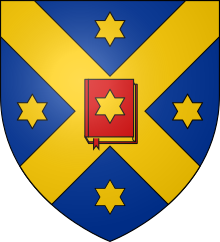
Back جامعة أوتاغو Arabic اوتاقو بیلیمیوردو AZB Univérsitas Otago BAN Universitat d'Otago Catalan University of Otago German Universitato de Otago Esperanto Universidad de Otago Spanish دانشگاه اتاگو Persian Otagon yliopisto Finnish Université d'Otago French
Māori: Ōtākou Whakaihu Waka | |
 | |
| Motto | Latin: Sapere aude |
|---|---|
Motto in English | Dare to be wise |
| Type | Public research collegiate university |
| Established | 1869; 152 years ago |
| Endowment | NZD $279.9 million (31 December 2021)[1] |
| Budget | NZD $756.8 million (31 December 2020)[2] |
| Chancellor | Stephen Higgs |
| Vice-Chancellor | Helen Nicholson (acting)[3] |
Academic staff | 1,744 (2019)[4] |
Administrative staff | 2,246 (2019)[4] |
| Students | 21,240 (2019)[4] |
| Undergraduates | 15,635 (2014)[4] |
| Postgraduates | 4,378 (2014)[4] |
| 1,579 (2019)[4] | |
| Location | , , New Zealand (Māori: Ōtepoti, Ōtākou, Aotearoa) 45°51′56″S 170°30′50″E / 45.86556°S 170.51389°E |
| Campus | Urban/University town 45 hectares (110 acres) |
| Student Magazine | Critic |
| Colours | Dunedin Blue and Gold |
| Affiliations | MNU |
| Website | https://www.otago.ac.nz |
 | |
The University of Otago (Māori: Ōtākou Whakaihu Waka[5]) is a public research collegiate university based in Dunedin, Otago, New Zealand. Founded in 1869, Otago is New Zealand's oldest university and one of the oldest universities in Oceania.[6]
The university was created by a committee led by Thomas Burns,[7] and officially established by an ordinance of the Otago Provincial Council in 1869.[8] Between 1874 and 1961 the University of Otago was a part of the federal University of New Zealand, and issued degrees in its name.[9]
Otago is known for its vibrant student life, particularly its flatting, which is often in old houses. Otago students have a long-standing tradition of naming their flats.[10][11][12] The nickname for Otago students, "Scarfie," comes from the habit of wearing a scarf during the cold southern winters.[13] The nickname "Scarfie" has morphed into the nickname "Breather" in recent years.[14][15] The university's graduation song, Gaudeamus igitur, iuvenes dum sumus ("Let us rejoice, while we are young"), acknowledges students will continue to live up to the challenge, if not always in the way intended. The university's student magazine, Critic, is New Zealand's longest running student magazine.
- ^ "University of Otago Foundation Trust Annual Report 2021" (PDF). Retrieved 1 December 2022.
- ^ "University of Otago Annual Report 2020" (PDF). Archived (PDF) from the original on 28 July 2021. Retrieved 28 July 2021.
- ^ Cite error: The named reference
NZH 14 June 2023was invoked but never defined (see the help page). - ^ a b c d e f "Quick Statistics about the University of Otago". Archived from the original on 9 February 2013. Retrieved 23 October 2007.
- ^ "Tō Tātou Tuakiritaka | Pride in our identity". University of Otago. 1 May 2024.
- ^ "Study at University of Otago, New Zealand | myglobaluni".
- ^ King, Michael (2003). Penguin History of New Zealand. Penguin Books. p. 209. ISBN 0-14-301867-1.
- ^ "Our History". www.otago.ac.nz. University of Otago. Archived from the original on 4 February 2021. Retrieved 6 September 2016.
- ^ "University of Otago, New Zealand". www.smc.edu. Retrieved 1 April 2022.
- ^ Chilton-Towle, Jonathan (3 March 2014). "Discovering stories behind flat names". Otago Daily Times. Archived from the original on 26 February 2021. Retrieved 19 August 2016.
- ^ Gallagher, Sarah (2013). "Dunedin Flat Names Project". Archived from the original on 17 February 2021. Retrieved 18 October 2021.
- ^ Gallagher, Sarah; Chapman, Ian (2019). Scarfie Flats of Dunedin. Auckland: Imagination Press. ISBN 9780995110441.
- ^ Secker, Nathan. "Scarfie Flats". Te Ara – The Encyclopedia of New Zealand. Archived from the original on 18 December 2012. Retrieved 10 October 2012.
- ^ "Where Did the Word "Breather" Come From?". Critic - Te Ārohi. Retrieved 19 December 2023.
- ^ Paul, Oscar (16 March 2021). "Once students were scarfies, now they're… 'breathers'?". The Spinoff. Retrieved 19 December 2023.
© MMXXIII Rich X Search. We shall prevail. All rights reserved. Rich X Search